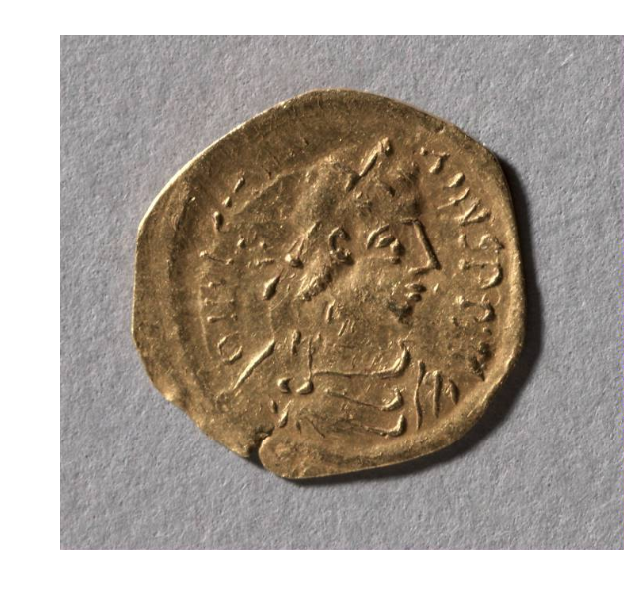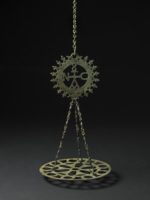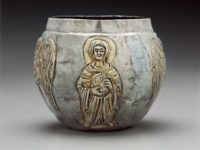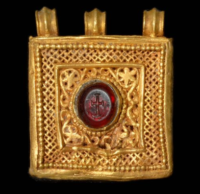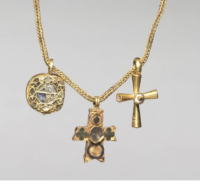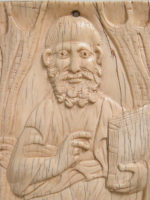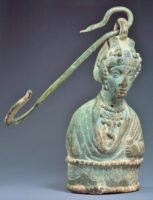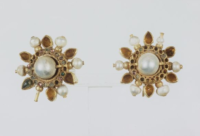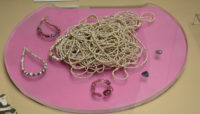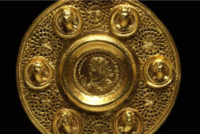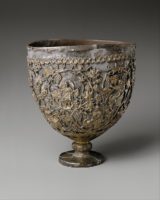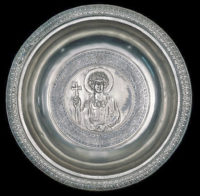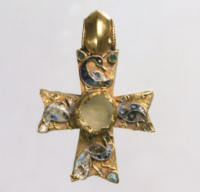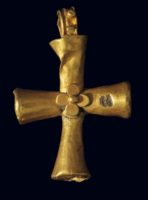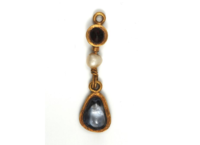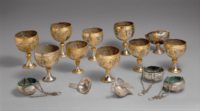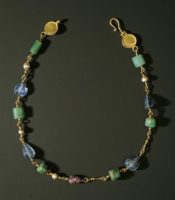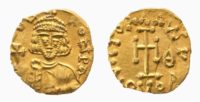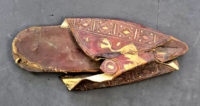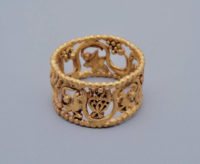Half Tremissis of Justinian I, 527-565, Minted in: Constantinople. Material: Gold. Diameter: w. 1.5 cm (9/16 in.). Cleveland Art Museum Hours: Tuesdays, Thursdays, Saturdays, Sundays 10:00 a.m.–5:00 p.m. Wednesdays, Fridays 10:00 a.m.–9:00 p.m. Closed Mondays.
Polycandelon in the form of a pierced disk with openwork cross and nine circular perforations; Period: Early Byzantine, circa: 6thc.-7thc. Materials: copper alloy. Dimensions: Diameter: 279 millimetresHeight: 757 millimetres (suspended)Weight: 1.626 kilograms. British Museum is closed 24, 25 and 26 December and 1 January, but is open every other day of the year. Fast facts about the British Museum: Founded: 1753, Collection size: 8 million objects, Oldest object in the collection: Stone chopping tool (nearly 2 million years old).
Spherical Small Container (pyxis) with Representations of Christ, Virgin and two Archangels. Period: Early Byzantine, circa: 6th–7th century A.D. Dimensions: Height x diameter: 7 x 9 cm (2 3/4 x 3 9/16 in.). Materials: Silver with gilding. This gilded silver pyxis of round kind was a container for antiques or scent made use of in Early Byzantine church ceremonies. The 4 figures created in repousse method reveal a bearded Christ offering a true blessing, the Virgin holding a symbol symbolic of her duties as Mother of God (Theotokos), as well as 2 angels worn lengthy sleeved chitons with segmenta on their shoulders and also hems. The cover is shed however could have had a dedicatory inscription.
The MFA is open 7 days a week. Monday and Tuesday 10 am–5 pm, Wednesday–Friday 10 am–10 pm, Saturday and Sunday 10 am–5 pm.
Reliquary of St. Zacharias, Period: Early Byzantine, 6th Century, Material: Gold and gems. The museum is open to the public Tuesday through Sunday, 11:30 a.m.–5:30 p.m., except for federal holidays.
Chain with Pendant and Two Crosses, Materials: Gold with enamel and glass. Period: Early Byzantine, 500’s. The Cleveland Art Museum Hours: Tuesdays, Thursdays, Saturdays, Sundays 10:00 a.m.–5:00 p.m. Wednesdays, Fridays 10:00 a.m.–9:00 p.m. Closed Mondays.
Panel with St. Peter or St. Paul, Period: Early Byzantine circa: 500s, Made in Byzantine Egypt, Materials: Ivory. Dimensions: 9 1/8 x 4 1/8 x 5/16 in. (23.1 x 10.5 x 0.8 cm). On view at The Met Fifth Avenue in Gallery 300. The Metropolitan Museum of Art (New York) is one of the world’s largest and finest art museums. Its collection includes more than two million works of art spanning five thousand years of world culture, from prehistory to the present and from every part of the globe. Public Hours: 10:30 a.m.–5:30 p.m. Open seven days a week.
Steelyard Weight with a Bust of a Byzantine Empress and a Hook. This Byzantine steelyard weight dates from the first half of the 5th century. The bronze hook would permit it to be suspended from and moved along a ruled steelyard to determine the weight of an item hung from the opposite end. The Metropolitan Museum of Art (New York) is one of the world’s largest and finest art museums. Its collection includes more than two million works of art spanning five thousand years of world culture, from prehistory to the present and from every part of the globe. Public Hours: 10:30 a.m.–5:30 p.m. Open seven days a week.
Pair of Earrings, Materials: Gold, Gems, Pearls and Garnets. Period: Early Byzantine, circa: early 5th century. The museum is open to the public Tuesday through Sunday, 11:30 a.m.–5:30 p.m., except for federal holidays.
Quantity of pearl, tourmaline, glass, coral and bronze beads, once attached no doubt to cloth. Period: Early Byzantine circa: 6-7th century. Made in/Findspot: Constantinople. In the Istanbul Archaeological Museum collections, there are rich and very important works of art belonging to various civilizations from the regions from Africa to Balkans , from Anatolia and Mesopotamia to Arab Peninsula and Afghanistan that were in the borders of the Ottoman Empire.
Circular Pendant with Double Solidus of Constantine I, Period: Early Byzantine, Materials: gold. The museum is open to the public Tuesday through Sunday, 11:30 a.m.–5:30 p.m., except for federal holidays.
The Antioch Chalice, Period: Early Byzantine, circa: 500–550, Made in Antioch or Kaper Koraon, Materials: Silver, silver-gilt. On view at The Met Fifth Avenue in Gallery 300. The Metropolitan Museum of Art (New York) is one of the world’s largest and finest art museums. Its collection includes more than two million works of art spanning five thousand years of world culture, from prehistory to the present and from every part of the globe. Public Hours: 10:30 a.m.–5:30 p.m. Open seven days a week.
Bowl; circular medallion with half-figure of a nimbed saint, St Sergios. Period: Early Byzantine; circa: 641-651; Materials: Silver. Production place: Made in Tarsus, Anatolia (Modern Turkey). Found: Acheripoetos Monastery, Cyprus,Nicosia. British Museum is closed 24, 25 and 26 December and 1 January, but is open every other day of the year.
Fast facts about the British Museum: Founded: 1753, Collection size: 8 million objects, Oldest object in the collection: Stone chopping tool (nearly 2 million years old).
Pendant Cross with Birds and Zoe-Phos, Period: Early Byzantine, circa Late 6th Century. Materials: filigree enamel on gold. The museum is open to the public Tuesday through Sunday, 11:30 a.m.–5:30 p.m., except for federal holidays.
Cross, with a decorative quatrefoil rosette at the juncture of the arms. Materials: gold. Period: Early Byzantine; circa: Early 7th c. The Benaki Museum of Greek Culture is housed in one of the most beautiful neoclassical-style buildings in Athens, near the National Garden and the Hellenic Parliament.
[xyz-ihs snippet="Benaki-Hotels"]Earring. Materials: Pearl, Ruby, Sapphire, Gold and gems. Period: Early Byzantine, circa: early 5th century. Found in 1910 during restoration work in Piazza della Consolazione, Rome. The museum is open to the public Tuesday through Sunday, 11:30 a.m.–5:30 p.m., except for federal holidays.
Necklace; Materials: Glass and Amber Beads, mall bone cross and a blue faience figure of Bes. Period: 5thc.-6thc, Early Byzantine. Found: Qaw el-Kebir, Upper Egypt. British Museum is closed 24, 25 and 26 December and 1 January, but is open every other day of the year.
The Attarouthi Treasure, Period: Early Byzantine, circa: 500-650s. Made in Attarouthi, Syria. Materials: Silver, silver-gilt. On view at The Met Fifth Avenue in Gallery 300.
These well-wrought liturgical items– chalices, censers, a filter, and also a depiction of the dove of the Holy Spirit– were amongst the belongings of a Christian church in the wealthy seller city of Attarouthi in Syria, after that among the wealthiest lands of the Byzantine Empire. The chalices, censers, and also filter were made use of for the Divine Liturgy, or Eucharist, where Christians take consecrated wine and bread in ceremony of the Last Supper and also Christ’s death. According to their inscriptions, written in Greek with several spelling variants, many of the objects were offerings of local citizens to the major church of the town, which was dedicated to Saint Stephen, and to a smaller church dedicated to Saint John (probably Saint John the Forerunner [the Baptist]). In the very early 7th century Syria dropped initially to the Sasanian Persians and afterwards to the militaries of Islam. These works were most likely hidden in haste in a safety container at some minute when the Byzantine military was pulling away from strikes on the area.
The Metropolitan Museum of Art (New York) is one of the world’s largest and finest art museums. Its collection includes more than two million works of art spanning five thousand years of world culture, from prehistory to the present and from every part of the globe. Public Hours: 10:30 a.m.–5:30 p.m. Open seven days a week.
[xyz-ihs snippet="Met-Museum-Booking"]Gold necklace with sapphires, amethysts, emeralds and pearls. Period: Early Byzantine. Place/Findspot: Antinoë in Egypt. The Ravenna mosaics portray this kind of precious jewelry, widespread during Early Christian times, being worn by ladies of the imperial court of Theodora.
The Benaki Museum of Greek Culture is housed in one of the most beautiful neoclassical-style buildings in Athens, near the National Garden and the Hellenic Parliament. It was converted into a museum in order to shelter the collections of Antonis Benakis and was donated to the Greek nation by himself and his three sisters, Alexandra, Penelope and Argine. Following its most recent refurbishment (1989–2000), the building houses a unique exhibition on Greek culture arranged diachronically from prehistory to the 20th century.
Gold Coin. Ruler: Leo III. Period: Middle Byzantine, circa: 717-741. Minted in: Ravenna. Weight: 1.484 grammes. British Museum is closed 24, 25 and 26 December and 1 January, but is open every other day of the year. Fast facts about the British Museum: Founded: 1753, Collection size: 8 million objects, Oldest object in the collection: Stone chopping tool (nearly 2 million years old).
Slipper; leather; with pointed toe and thick sole with gilt borders on the upper part and the figure of an animal. Culture: Coptic. Period: Early Byzantine; circa: 4thC-6thC; Made in: Egypt. Length: 262 millimetres. British Museum is closed 24, 25 and 26 December and 1 January, but is open every other day of the year. Fast facts about the British Museum: Founded: 1753, Collection size: 8 million objects, Oldest object in the collection: Stone chopping tool (nearly 2 million years old).
Ring in openwork filigree, Period: Early Byzantine circa (A.D. 550–650). Materials: Gold. The MFA is open 7 days a week. Monday and Tuesday 10 am–5 pm, Wednesday–Friday 10 am–10 pm, Saturday and Sunday 10 am–5 pm.


